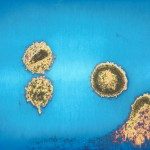Link to Pubmed [PMID] – 24219908
Retrovirology 2013;10:131
BACKGROUND: SAMHD1 is a restriction factor that potently blocks infection by HIV-1 and other retroviruses. We have previously demonstrated that SAMHD1 oligomerizes in mammalian cells by immunoprecipitation. Here we investigated the contribution of SAMHD1 oligomerization to retroviral restriction.
RESULTS: Structural analysis of SAMHD1 and homologous HD domain proteins revealed that key hydrophobic residues Y146, Y154, L428 and Y432 stabilize the extensive dimer interface observed in the SAMHD1 crystal structure. Full-length SAMHD1 variants Y146S/Y154S and L428S/Y432S lost their ability to oligomerize tested by immunoprecipitation in mammalian cells. In agreement with these observations, the Y146S/Y154S variant of a bacterial construct expressing the HD domain of human SAMHD1 (residues 109-626) disrupted the dGTP-dependent tetramerization of SAMHD1 in vitro. Tetramerization-defective variants of the full-length SAMHD1 immunoprecipitated from mammalian cells and of the bacterially-expressed HD domain construct lost their dNTPase activity. The nuclease activity of the HD domain construct was not perturbed by the Y146S/Y154S mutations. Remarkably, oligomerization-deficient SAMHD1 variants potently restricted HIV-1 infection.
CONCLUSIONS: These results suggested that SAMHD1 oligomerization is not required for the ability of the protein to block HIV-1 infection.

